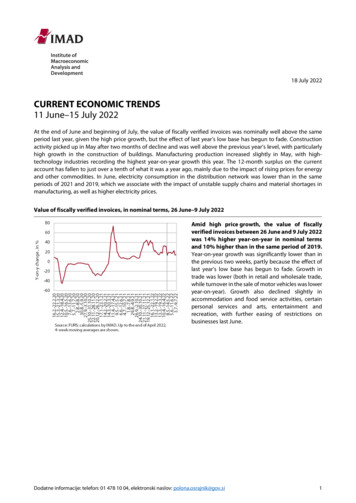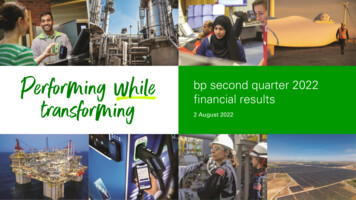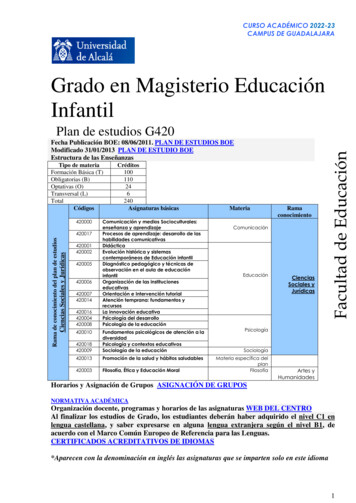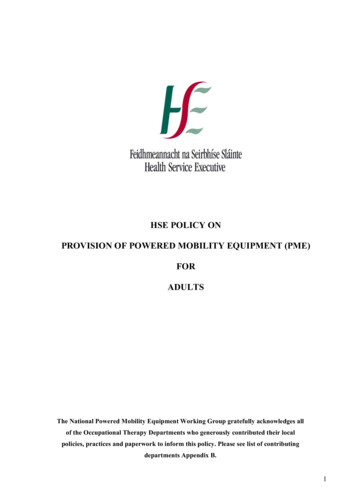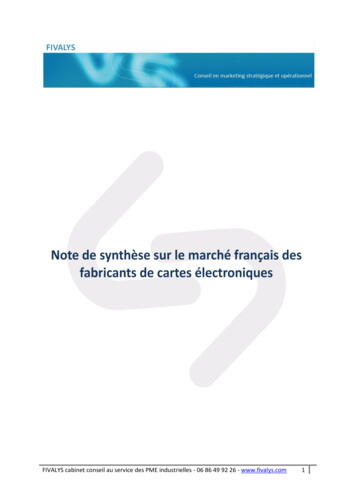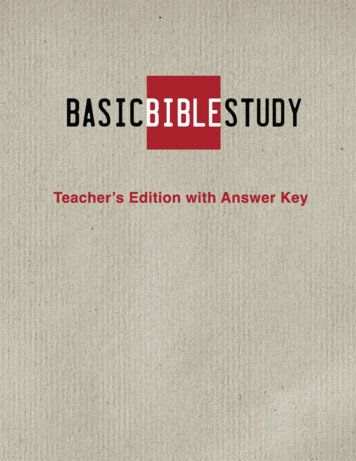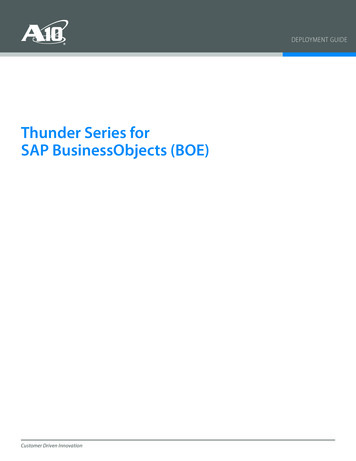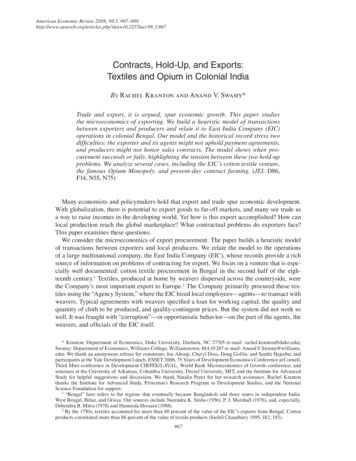
Transcription
American Economic Review 2008, 98:3, 967–989http://www.aeaweb.org/articles.php?doi 10.1257/aer.98.3.967 POUSBDUT )PME 6Q BOE &YQPSUT 5FYUJMFT BOE 0QJVN JO PMPOJBM *OEJBBy Rachel Kranton and Anand V. Swamy*Trade and export, it is argued, spur economic growth. This paper studiesthe microeconomics of exporting. We build a heuristic model of transactionsbetween exporters and producers and relate it to East India Company (EIC)operations in colonial Bengal. Our model and the historical record stress twodifficulties: the exporter and its agents might not uphold payment agreements,and producers might not honor sales contracts. The model shows when procurement succeeds or fails, highlighting the tension between these two hold-upproblems. We analyze several cases, including the EIC’s cotton textile venture,the famous Opium Monopoly, and present-day contract farming. (JEL D86,F14, N55, N75)Many economists and policymakers hold that export and trade spur economic development.With globalization, there is potential to export goods to far-off markets, and many see trade asa way to raise incomes in the developing world. Yet how is this export accomplished? How canlocal production reach the global marketplace? What contractual problems do exporters face?This paper examines these questions.We consider the microeconomics of export procurement. The paper builds a heuristic modelof transactions between exporters and local producers. We relate the model to the operationsof a large multinational company, the East India Company (EIC), whose records provide a richsource of information on problems of contracting for export. We focus on a venture that is especially well documented: cotton textile procurement in Bengal in the second half of the eighteenth century.1 Textiles, produced at home by weavers dispersed across the countryside, werethe Company’s most important export to Europe.2 The Company primarily procured these textiles using the “Agency System,” where the EIC hired local employees—agents—to transact withweavers. Typical agreements with weavers specified a loan for working capital, the quality andquantity of cloth to be produced, and quality-contingent prices. But the system did not work sowell. It was fraught with “corruption”—or opportunistic behavior—on the part of the agents, theweavers, and officials of the EIC itself.* Kranton: Department of Economics, Duke University, Durham, NC 27705 (e-mail: rachel.kranton@duke.edu);Swamy: Department of Economics, Williams College, Williamstown, MA 01267 (e-mail: Anand.V.Swamy@williams.edu). We thank an anonymous referee for comments; Joe Altonji, Cheryl Doss, Doug Gollin, and Santhi Hejeebu; andparticipants at the Yale Development Lunch, ESSET 2006, 75 Years of Development Economics Conference at Cornell,Third Mini-conference in Development CIRPÉE/LAVAL, World Bank Microeconomics of Growth conference, andseminars at the University of Arkansas, Columbia University, Drexel University, MIT, and the Institute for AdvancedStudy for helpful suggestions and discussion. We thank Natalia Perez for her research assistance. Rachel Krantonthanks the Institute for Advanced Study, Princeton’s Research Program in Development Studies, and the NationalScience Foundation for support.1“Bengal” here refers to the regions that eventually became Bangladesh and three states in independent India:West Bengal, Bihar, and Orissa. Our sources include Narendra K. Sinha (1956), P. J. Marshall (1976), and, especially,Debendra B. Mitra (1978) and Hameeda Hossain (1988).2By the 1750s, textiles accounted for more than 80 percent of the value of the EIC’s exports from Bengal. Cottonproducts constituted more than 88 percent of the value of textile products (Sushil Chaudhury 1995, 182, 192).967
968THE AMERICAN ECONOMIC REVIEWJUNE 2008We build a model of this procurement system and highlight two problems we see throughoutthe historical record. Agents often did not uphold payment agreements and cheated the weavers,and weavers often sold output to other buyers and thereby did not repay their debts. Our analysisshows the difficulty of solving both problems at the same time. If the EIC gave the agent moreauthority to prevent outside sales, it simultaneously gave the agent a greater ability to hold-upthe weaver and not make the specified payments. In the history we see that the EIC struggledto find the right balance. The model shows how this balance depends on the market structure,the specialized nature of the good, and uncertainty over local bargaining between the agent andproducer.The study provides lessons for historical and present-day procurement. The EIC’s procurementprocess is a typical one: there is an advance of working capital or inputs, and goods are producedand then delivered at a later date when final compensation is made. If long-term agreements cannot be enforced, the basic setting falls within the general paradigm of incomplete contracting(Oliver E. Williamson 1975; Sanford J. Grossman and Oliver D. Hart 1986; Hart and John Moore1990). We see this theory come to life in the EIC records. Two parties make specific investments: the company and agent advance funds to a producer, and the producer makes the clothto the buyer’s specifications. The terms of the agreement are difficult to enforce, hence there ispotential for opportunistic behavior on both sides. While the general consequences of hold-upare well known, the closest paper we know to our model is that of Aaron S. Edlin and BenjaminE. Hermalin (2000), which explicitly gives the producer property rights over the output, allowinghim to sell to another buyer.3 The development literature emphasizes producers who can renegeon debt agreements, but a buyer who can renege on an agreement with a producer does not oftenappear, with Abhijit V. Banerjee and Esther Duflo (2000) being a notable exception.4 To ourknowledge there is no analysis of the situation, likely to be quite common, where both problemsand outside sales are present.We present a stylized (one could say reduced-form) model of one-time interaction betweenan exporter and a local producer. We ask when the exporter, its agent, and the producer allhave incentives to uphold contract terms. An alternative approach would be a model of repeatedinteraction. Absent competition, such a model could yield the familiar result that, if players aresufficiently patient, gains from trade can be consistently realized. While this may be an accuratedescription of interactions in some settings, we often do not see such behavior in our study oftextile procurement. We will describe competition among buyers and contractual violations byproducers, agents, and exporters who do not seem to fear future retaliation and do not seem to bethinking long term. We elaborate reasons for this outcome in Section III.Beyond the EIC’s textile venture, we study its (in)famous opium operations and its land taxcollection efforts in eastern India, and we discuss present-day contract farming in developingcountries. Our model indicates that successful procurement requires a balance of bargainingpower between the agent and the producer. In the textile case, the EIC faced three difficulties inmaintaining this balance. First, competition from other buyers gave weavers the ability to sellelsewhere. Second, the EIC was not able to monitor its agents well and did not know how itsregulations mapped into effective power of its agents. Corruption among senior company officials aggravated the problem. Third, the local EIC was constrained in its pricing policies by itsdirectors in London, making it more difficult, as shown in our model, to satisfy the incentives3Another literature studies problems due to producers’ hidden characteristics (e.g. James E. Rauch and Joel Watson2003).4Marcel Fafchamps (1997), John McMillan and Christopher Woodruff (1999), and Tyler Biggs, Mayank Raturi,and Pradeep Srivastava (2002) discuss trade credit. There is also an extensive literature on interlinkage as a solutionto moral hazard and enforcement problems in credit contracts in agriculture. Pranab K. Bardhan (1980, 1989) providesoverviews of this literature.
VOL. 98 NO. 3KRANTON AND SWAMY: TEXTILES AND OPIUM IN COLONIAL INDIA969of both agents and producers. In later opium operations, these problems were less salient. TheOpium Agency, initiated by the EIC, was an explicit and declared monopsony/monopoly—alllegal poppy cultivation was for the agency, and sale was only through the agency. Though therewas some smuggling, local producers had fewer outside options. It also had greater discretionover prices. The Opium Agency also mitigated corruption in key transactions by hiring personnel and instituting procedures to monitor agents. We argue these features were complementary;the monopsony mitigated the hold-up ability of the producer, and monopoly rents from selling ahighly lucrative product provided the incentive to invest in a monitoring system. Greater integrity among senior officials facilitated such monitoring.Our study of the EIC’s land tax collection supports this interpretation of procurement operations.5 The company again relied on local agents, and we see a similar struggle to give agents theright amount of power in their tax collection efforts and dealings with tenant farmers.This paper contributes to the study of the role of institutions in economic growth and development. Following Douglass C. North (1990), economic historians have explored how institutionscan foster expanding trade. In a prominent example, Avner Greif (1993) shows how a communityof traders successfully transported goods from one port to another, despite agency problems. Ourstudy considers how goods make it to port in the first place. Several papers study the internalmanagement of the EIC and other trading companies (e.g. Ann M. Carlos and Stephen Nicholas1990; Santhi Hejeebu 2005). None of this work focuses on contractual relations with producers,which is our main interest. In the conclusion, we apply our model to contract farming in today’sdeveloping world.The rest of the paper is organized as follows. In the next section we discuss the historicalbackground of the EIC and its cotton textile procurement in Bengal. Section II presents a modelof export procurement. Section III draws on the model and discusses the evolution of the EIC’stextile procurement policies, the Opium Agency, and land tax collection efforts. Section IVconcludes.I. The EIC in Bengal and Cotton Textile ProcurementThe English East India Company was founded in 1600 with a monopoly on English trade withEurope from east of the Cape of Good Hope to the Straits of Magellan. The EIC operated in manyparts of the world, including the American colonies, India, and China. We study operations ineastern India after 1757, when, in the Battle of Plassey, the EIC defeated the Nawab of Bengal,establishing itself as the dominant political authority. The company’s de facto power graduallybecame de jure power: after initially operating via client rulers, the company gained the rightsto collect land revenues in 1765, formally took over revenue and civil judicial administration in1772, and in 1790 eliminated the vestiges of the Nawab’s last remaining role, in administrationof criminal law.6 The British gradually established an administrative system. Substantial effortsto curb corruption among top-level (European) employees began toward the end of the eighteenth century, and selection and management procedures were subsequently further improved.5The EIC collected land taxes in its role as Diwan of Bengal. See the historical review below.The company initially relied heavily on the Nawab’s officers. But traditional forms of authority were at odds withchanged political realities. In 1772, under Warren Hastings, the first Governor-General, the company explicitly tookover revenue and civil judicial administration. At the outset a civil court, known as Diwani Adalat, was established ineach district, headed by the “collector,” the company official in charge of collection of land revenue. Over the next fewdecades, the system was modified repeatedly. In 1773, the collectors were replaced with Indian judicial officers (naibs)whose work was supervised by one of six “Provincial Courts” in the charge of company officials. When the burden onthese courts became too great, British officials were again (in 1781) dispersed through 18 mofussil (district) DiwaniAdalats which, henceforth, were central to the civil judiciary (B. B. Misra 1959, 1961).6
970THE AMERICAN ECONOMIC REVIEWJUNE 2008To govern a vast and unfamiliar territory, the company relied heavily on Indian intermediaries;7effective procedures for their supervision evolved slowly and were not consolidated until thesecond half of the nineteenth century (Peter Robb 1997). We will see how the increasing abilityto monitor employees and enforce contracts affected the textile, opium, and land tax collectionventures.8We first study the EIC’s cotton textile operations. Textiles were made by weavers using handlooms in their homes. Weaving was often not a sole occupation but combined with farming,and production was dispersed throughout the countryside. Bengali textiles had several outlets:local consumers, markets in upper India to which Bengal is connected by major rivers, andexports to regions outside South Asia.9 By the end of seventeenth century, Bengali textiles werevery popular in Europe, as during the “Indian Craze” of the 1680s. Other European companies,including the Dutch, French, and Danish, were active in the market. Trade volume was large;Om Prakash (1976, 173) estimates that in the early eighteenth century Dutch and English textileexports created 75,000–100,000 jobs.10 By the first half of the eighteenth century, Europe wasthe major export market.11 Besides European companies, local merchants and private tradersfrom Europe, India, and elsewhere in Asia sought to buy cloth. One source was the spot market,where a “ready money” (khush khareed) purchase could be made. A buyer could also advancecapital to a weaver for purchase of inputs, including yarn, in return for a commitment to producefor him—an arrangement called dadan. Such arrangements were advantageous to the weaver:he received capital, and he was guaranteed (in principle) a buyer for his product. The buyer wasguaranteed (again, in principle) supply, made to specifications. Timely and assured procurementwas particularly important for European companies, whose ships made journeys lasting manymonths. In its “Contract System,” the EIC placed orders with local merchants who advancedcapital and procured cloth. In its “Agency System,” the company hired salaried employees inorder to deal directly with the weavers.The EIC predominantly used the Agency System in the period we study, and we describeit here in further detail. The EIC established “factories”—administrative offices—in majortowns.12 Each factory linked several collection centers, aurung, headed by salaried employees,7In 1773, there were only 250 officers in the company’s civil service in Bengal. European rank and file soldiersand officers in the company’s army accounted for only 3,000 and 500, respectively, in 1769 (Marshall 1976, 15–16).In contrast, an estimated 20 million people lived in the province of Bengal by the early eighteenth century (Prakash1976, 174).8After becoming a territorial power in eastern India, the company itself was increasingly supervised by the government in London which was concerned that Bengal was being mismanaged. As Percival Griffiths (1952, 156) putsit, “a trading corporation could no longer be allowed to handle uncontrolled an empire in embryo.” The company’sbargaining position was also weakened by its dependence on the government during financial crises. The India Act of1784 set up a Board of Control to supervise administrative, revenue, and political decisions of the company. The Boardof Control’s power grew steadily, and the company’s privileges were gradually eliminated: in 1813 it lost its monopolytrading right with India; after 1833 its commercial operations were ended and the company was a purely political andadministrative entity in India (as discussed in Section IIIB, the revenues from the opium trade were not commercialprofits for the EIC); finally, in 1858, after a large-scale rebellion in northern and central India, the British Crowndirectly took over Indian administration.9Chaudhury (1995, 147) lists Southeast Asia, West and Central Asia, the Persian Gulf and Red Sea areas, and NorthAfrica.10Prakash (1976, 173) provides lower and upper bounds of 75,620 and 99,804 for employment in production of cotton and silk textiles taken together. While employment figures are not broken down further, it is estimated that 87 percent of the looms were used for cotton-only products (180). The workforce in Bengal province at this time is estimatedat 10 million, 1 million of whom were in textiles and raw silk taken together.11See Chaudhuri (1978, 247).12Chaudhuri (1978, 573) writes: “The term ‘factory’ at this time merely signified an establishment for the merchantsto carry on business from within a foreign country and it is derived from the word ‘factor’ meaning an agent employedby the principal merchant.”
VOL. 98 NO. 3KRANTON AND SWAMY: TEXTILES AND OPIUM IN COLONIAL INDIA971gumashtas, who served as the EIC’s agents.13 In the early years, agents posted bonds with thecompany. The company gave agents funds to advance to weavers14 and specified the amountsand types of cloth needed and a price schedule. The gumashta would contract with the weaver,advancing capital in return for specified cloth. If the gumashta received the cloth, he and his staffevaluated it, sent the cloth to the EIC’s factory, and paid the weaver. To recover the final product,the gumashta could use coercive measures, which varied in severity over the period we study.The extent of gumashtas’ coercive power was a policy decision of the EIC. It is these policies wewill discuss at length in Section III.There is considerable evidence that this system was plagued by opportunism of both agentsand weavers. For instance, a petition submitted by weavers in 1795 had a long list of complaints,including the following accusations of cheating: “At the end of the year, the said gomastah underthe pretence that there is a deficiency in the measurement, deducts four annas, eight annas, or arupee from the price of each piece ”; “From the year 1789 to 1973 (five years) he deducted fromour advances one thousand six hundred and twenty rupees which he said was for the Collector’suse”; “He gets rupee of full weight from the Collector’s treasury and gives us those that aredeficient” (Debendra B. Mitra 1978, 233–34). For their part, the weavers also often violatedagreements, taking advances from the company but selling to other buyers, as we discuss furtherin Section III.The EIC experimented with various policies to address these issues. Our analysis shows whysolving both problems was a difficult task. The gumashta needed coercive power to secure thesale of the cloth, but this power in turn gave the agent the ability to hold up the weaver. The solution to one contractual problem created the other.We show the workings of transactions in a simple model.II. A Model of ProcurementThere is an export good produced using capital, k, and labor, l. A producer has the skill toproduce the good, but no capital. The exporter has the capital to produce the good, but no skill.We normalize the interest rate to zero and set labor costs equal to the quantity of labor used.––There is fixed proportions technology, where inputs k k and l l result in a single indivisible– –unit of the good. The exporter has value v– for the good, where v– 2 k 2 l 0, so the good isefficient to produce.We focus on one producer and one exporter, given there are many other producers and potentially other buyers. We suppose, for simplicity, that other buyers would pay mv– for the product,where the parameter m, 0 # m # 1, represents the extent of competition. For example, m couldrepresent the extent to which the good is specific to the exporter who provides the capital. Form 5 1, the good is homogeneous, and there are other buyers willing to pay v– for the output.15 Wesometimes call mv– the “spot market price.”13It appears that there was a single gumashta at each collection center. We could not determine the length of time agumashta typically served, nor do we see evidence of tournaments.14The Agency System policy when it was first formulated in 1753 stated: “The substantial gomastahs approvedof by the Board should be employed at the aurungs, giving sufficient security that they undertake no other than theHonourable Company’s business on forfeiture of their wages and allowance, that each gomastah have different mustersdelivered to him for his guide that no gomastah be entrusted with more than Rs. 20,000 at one time ” (HameedaHossain 1988, 87).15The specificity of the good could be a choice of the exporter or the producer, and the model could accommodatethis possibility. The qualitative results would not change.
972THE AMERICAN ECONOMIC REVIEWJUNE 2008A. Exporter-Producer Interaction with No IntermediaryThe producer and exporter, with no intermediary, interact as follows. The exporter announcesa price P that it will pay for the good and an amount of capital k to give to the producer. The producer decides whether to accept the capital and then whether to produce a good. If he produces,the producer decides whether to sell the good to the exporter or to another buyer. The exporterdecides whether or not to pay the promised price P.16If the price and all other terms are enforceable, the exporter simply sets P to maximize his––profits P 5 v– 2 k 2 P, subject only to the producer’s participation constraint, P 2 l 0. Theexporter earns the full surplus from exchange.When the producer’s decision to sell to the exporter is not enforceable, the producer could usethe capital for another purpose or produce output but sell to another buyer. This is the typicalproblem studied in the development literature. The promised, and still enforceable, price must– –then satisfy two incentive constraints: (1) P l 1 k , so the producer has the incentive to uselabor and capital for production;17 and (2) P mv–, so that the producer has the incentive to sell– –to the exporter. The exporter would set P 5 max5l 1 k , mv– 6, and its profits are positive if and–––only if m # 1v– 2 k 2/ v– and v– 2k 1 l . The competition cannot be so strong that a high priceerodes the exporter’s returns, and the value of the good must cover the producer’s incentive touse capital for production.B. The Exporter Hires an IntermediaryNow let the exporter hire an employee—an “agent”—to ameliorate this enforcement problem.The exporter pays the agent a wage w 0. The agent’s responsibilities are to advance the capitalto the producer, collect the good upon its completion, pay the producer, and deliver the cloth to– –the exporter. The agent has an outside opportunity to earn U, and we now assume v– 2 k 2 l 2 U 0, so that the good’s value exceeds the agent’s opportunity cost as well as production costs.Unlike the exporter, the employee has some capability to monitor the producer and enforce thesale. This capability could derive from several sources. Public policies could grant agents rightsin enforcing contracts, e.g., by allowing them to enter homes and seize property. The agent couldhave his own ability to sanction a producer through social connections, dunning, or violence.We assume the exporter cannot always observe the agent’s interactions with the producer, andthe agent, by virtue of his coercive powers, could ultimately pay a price different from P.18 Theexporter could, however, have some ability to affect the agent’s power—either through its ownmanagement practices or through its influence on public policy.We capture the interaction between the agent and producer with a reduced-form bargainingmodel. Outside buyers would pay a price mv– for the product. We suppose the agent procurescloth and pays the producer 11 2 b 2 mv–, where 0 # b # 1.19 We call b the power of the agent.It summarizes the agent’s ability to prevent the producer from selling to another buyer, e.g.,16In sum, the producer should receive k and then P from the exporter.This incentive constraint is stronger than the producer’s participation constraint. Hence, we need work only withthe incentive constraint.18If the agent is able to completely enforce the debt/sales contract, and the exporter can perfectly monitor the agent,we simply return to our perfect enforceability case with the addition of an agent participation constraint.19The agent always obtains the good, as in equilibria of complete information bargaining games. But historicallyproducers often sold to outside buyers. Thus, we have a familiar dichotomy between historical events and equilibriumoutcomes. We could specify that the agent has only a probability of obtaining the cloth, and this probability is relatedto his power. This specification would complicate the analysis without changing its basic message.17
VOL. 98 NO. 3Exporter setsprocurementterms (P, etc.).Exporteroffers wage toagent toexecutecontract.KRANTON AND SWAMY: TEXTILES AND OPIUM IN COLONIAL INDIAAgent rejectsor accepts. Ifaccepts, agentreceiveswage, givessecurity toexporter inreturn for k.Agent chooseswhether toadvance k toproducer.Produceraccepts/rejects.If nocontracting,agent returnsk to exporter,recoverssecurity.If contracting,producerdecideswhether toproduce, andthen whetherto sell toagent or otherbuyer.973Agentdelivers anyoutputprocured toexporter andreceives P.Figure 1the ability to monitor the producer or harass and coerce him.20 Such mechanisms reduce theproducer’s return from outside sales, giving him an “outside option” of 11 2 b 2 mv–. When b islow, the agent has little power and must pay the producer close the spot market price to obtainthe cloth. When b is high, the agent can obtain the cloth from the producer at much lower thanthe spot market price.21We begin with the simplest case: b is exogenous, and it is a known constant value. We laterconsider the case where the agent’s power is random and unknown to the exporter, but theexporter can affect its distribution.The exporter, the agent, and the producer interact as follows (see Figure 1). The exporterannounces procurement terms—the capital advance to the producer, the final good price P, andthe agent’s wage w. If the agent accepts, he gives the exporter a security Q in return for the––advance k , where Q . k . He chooses how much capital to forward to the producer. The producerthen chooses whether or not to produce. If the product is made, the agent obtains the cloth, delivers it to the exporter, receives P, and pays the producer 11 2 b 2 mv– .22 If the agent did not forwardthe capital, he simply returns it and recovers his security.Working backward, we now have three constraints. The producer will produce if and only ifhis revenues exceed his opportunity cost of capital and labor:23(1)– –11 2 b 2 mv– k 1l .20We could further specify that, beyond recovering the cloth, the agent can extract some capital/cash from the producer. Such a specification would change the producer’s and agent’s incentive constraints. Hiring the agent would bemore valuable to the exporter. The producer would earn fewer rents, thereby matching some historical accounts. Ourqualitative results regarding the balance between agent and producer would again be similar.21The model is a version of a Nash bargaining model, where each party earns its ex post outside option plus someshare of the gains from trade. We set the producer’s share to zero, reflecting the historical record that producers gainedvery little surplus from textile production. If we supposed the producer earned a strictly positive share, the producer’sincentive constraint would include the price P that the exporter ultimately pays the agent. This specification wouldagain complicate the analysis without changing the basic message.22We could add an agent’s choice to sell the cloth on the spot market rather than to the exporter. In this case, theexporter must set P mv– to ensure procurement. The outcome, however, is identical, as the exporter ultimately adjuststhe wage to extract rents from the agent (see below). In the EIC textile case, M. Jones (1918, 38) mentions the problemof outside sales by the agent, but it is not prominent in the literature.23This incentive constraint is stronger than the producer’s participation constraint; hence, we will work only withthe incentive constraint.
974THE AMERICAN ECONOMIC REVIEWJUNE 2008The agent will forward the capital if and only if he anticipates earning more from procuring cloththan simply returning the capital to the exporter:P 2 11 2 b 2 mv– 0.(2)Finally, the agent’s total earnings must exceed those in an alternative occupation:P 2 11 2 b 2 mv– 1 w U.(3)–The exporter sets P and w to maximize profits P 5 v– 2 k 2 P 2 w subject to (1), (2), and (3).Assuming the agent’s participation constraint is binding,24 (3), we have P* 5 11 2 b 2 mv–, w* 5 U,and exporter profits of(4)–P* 5 v– 2 11 2 b 2 mv– 2 k 2 U.We can now see how procurement depends on the level of the agent’s power b. The power mustbe high enough so that the exporter earns positive profits, P* 0, and low enough so that theremaining constraint, the producer’s incentive constraint (1), is satisfied. Setting P* 5 0 gives usa lower bound on b, and setting (1) as an equality gives us an upper bound on b:(5)12–– –v– 2 k 2 Uk 1l#b#12.mv–mv–Procurement, thus, occurs only when the coercive power of the agent is neither too high nor too– –low. We first observe that (5) is not satisfied for any level 0 # b # 1 if v– , 2k 1 l 1 U or m– – –, 1 k 1 l 2/ v . If the exporter’s value is too low, his profits ar
background of the EIC and its cotton textile procurement in Bengal. Section II presents a model of export procurement. Section III draws on the model and discusses the evolution of the EIC's textile procurement policies, the Opium Agency, and land tax collection efforts. Section IV concludes. I. The EIC in Bengal and Cotton Textile Procurement

